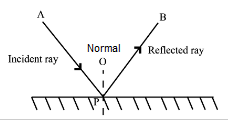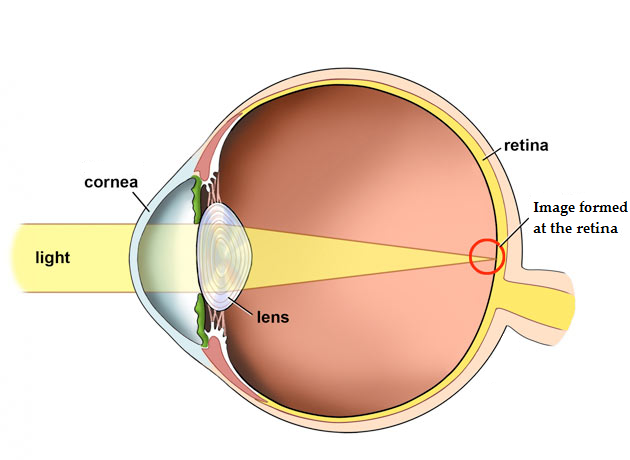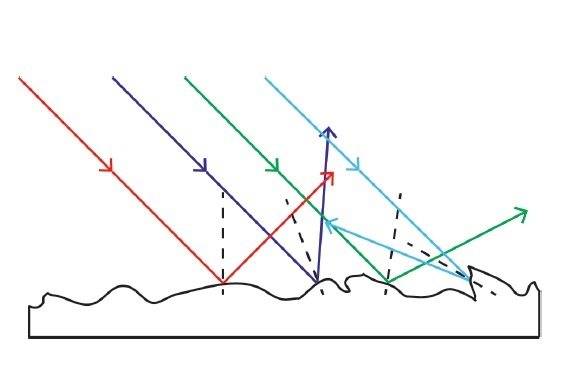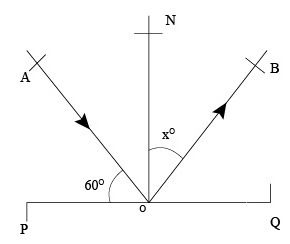8th Grade > Physics
LIGHT MCQs
Total Questions : 54
| Page 2 of 6 pages
Answer: Option B. -> Periscope
:
B
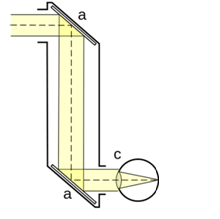
In a periscope, light rays are reflected twice so that we can indirectly see the objects from different position. As you can observe from the figure, the beams of light are reflected by the two mirror surfaces one after the other.Magnifying lens,microscopes and spectacles have lenses in them and reflection is not the primary principle for working of these equipments.
:
B

In a periscope, light rays are reflected twice so that we can indirectly see the objects from different position. As you can observe from the figure, the beams of light are reflected by the two mirror surfaces one after the other.Magnifying lens,microscopes and spectacles have lenses in them and reflection is not the primary principle for working of these equipments.
Answer: Option C. -> Angle of incidence = Angle of reflection.
:
C
According to the laws of reflection,
The angle of incidence is equal to theangle of reflection.
Or,
Angle of incidence = Angle of reflection
:
C
According to the laws of reflection,
The angle of incidence is equal to theangle of reflection.
Or,
Angle of incidence = Angle of reflection
Answer: Option B. -> 5
:
B
Whenever two plane mirrors are kept inclined to each other, multiple reflections takes place and multiple images are formed.
If the angle of inclination between two plane mirrors is 'x' degrees, the number of images formed, 'n' is given by,
n=360x−1
In this case, x = 60 degrees.
n=36060−1
n=6−1
n=5
Thus, the number images formed is 5.
:
B
Whenever two plane mirrors are kept inclined to each other, multiple reflections takes place and multiple images are formed.
If the angle of inclination between two plane mirrors is 'x' degrees, the number of images formed, 'n' is given by,
n=360x−1
In this case, x = 60 degrees.
n=36060−1
n=6−1
n=5
Thus, the number images formed is 5.
Answer: Option A. -> 30∘
:
A
∠AOP+∠AON=90∘ (as ON is perpendicular to POQ)
Given, ∠AOP=60∘
⟹∠AON=90∘−60∘
∠AON=30∘
By Laws of reflection,
∠AON=∠BON=x
Thus, x=30∘
:
A
∠AOP+∠AON=90∘ (as ON is perpendicular to POQ)
Given, ∠AOP=60∘
⟹∠AON=90∘−60∘
∠AON=30∘
By Laws of reflection,
∠AON=∠BON=x
Thus, x=30∘
Answer: Option B. -> False
:
B
Shape of eye lens changes as we try to focus on objects at different distances. Ciliary muscles holding the lens contracts and relaxes to bring about such a change in the lens.
:
B
Shape of eye lens changes as we try to focus on objects at different distances. Ciliary muscles holding the lens contracts and relaxes to bring about such a change in the lens.
Answer: Option A. -> Dispersion of light by water droplets present in the atmosphere
:
A
Rainbows are formed because of dispersion of light by the water droplets present in the atmosphere. When the white light passes through the water droplets suspended in the atmosphere, it is dispersed into its seven constituent colors which we call as a rainbow.
:
A
Rainbows are formed because of dispersion of light by the water droplets present in the atmosphere. When the white light passes through the water droplets suspended in the atmosphere, it is dispersed into its seven constituent colors which we call as a rainbow.
Answer: Option D. -> Both the statements are incorrect
:
D
There are two kinds of sensitive cells present in the retina:
(i) Cones, which are sensitive to bright light and
(ii) Rods, which are sensitive to dim light.
Besides, cones are sensitive to colour.
Thus, both the statements in the question are incorrect.
:
D
There are two kinds of sensitive cells present in the retina:
(i) Cones, which are sensitive to bright light and
(ii) Rods, which are sensitive to dim light.
Besides, cones are sensitive to colour.
Thus, both the statements in the question are incorrect.

